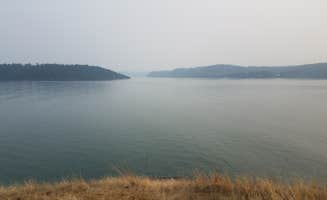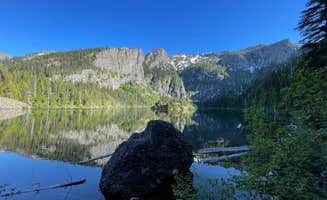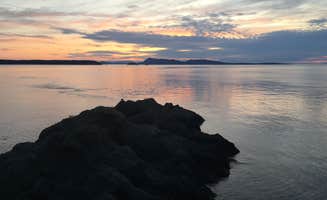Dispersed camping near Keystone Harbor provides primitive options in Washington's forested landscapes and marine environments. The area experiences mild summers with temperatures averaging 65-75°F and wet winters with significant rainfall exceeding 45 inches annually. Campsites range from sea level locations to higher elevation forest service roads where cellular reception becomes increasingly limited.
What to do
Kayaking to isolated campsites: Hope Island Marine State Park - Skagit County offers a unique paddle-in camping experience. "Not your typical camping trip!" notes Raphaela H. "Rent kayaks (or bring your own) at Boston Harbor in Olympia. It's a short trip to the island, which is only accessible by boat."
Hike forest trails: At Lake Angeles — Olympic National Park, campers can access backcountry sites after a challenging trek. "Hike is about 4 miles from the trailhead with ~2,500ft of elevation gain. Trailhead is right by the toll booths for the park," explains Luis N.
Wildlife viewing: Point Doughty provides excellent marine wildlife observation opportunities. One camper reports, "Actually the beach was quite pleasant as 2 orca whales cavorted just 100' off and a stellar sea lion, harbor seals and many sea bird varieties provided fantastic entertainment."
What campers like
Solitude and privacy: The remoteness of some sites ensures quiet experiences. At Hope Island, one camper shared, "We ended up being the only people on the island," while another appreciated the "romantic setting" of the small island environment.
River access: Mountain Loop Hway Dispersed Camp features waterside camping. "Meandering sites along the river with good logs for benches and fire rings made from forest rocks. Heavily forested and beautiful," notes Jennifer H., highlighting the natural amenities.
Forest road camping: Free camping near Keystone Harbor includes sites on forest service roads. "There was a handful of large pull out spots along this road. Nothing fancy and not secluded but got the job done," explains Bobby J. about Large Pull Out on FR 24.
What you should know
Road conditions vary: Access to dispersed sites requires preparation. For NF-27 Tunnel Creek, one reviewer notes, "The drive up to this road is half paved and unpaved, not too bumpy. Big area for camp-dry camping."
Bring bug protection: Insects can be problematic during warmer months. At NF-27 Tunnel Creek, campers report "lots of mosquitoes around," while Lake Angeles campers are advised "bring bug repellant" due to high insect activity.
Bathroom facilities limited: Most dispersed camping locations lack restroom facilities. Where available, maintenance may be inconsistent. At Point Doughty, a camper noted the "vault toilet had no toilet paper and was quite unsavory."
Marine access challenges: Water-based camping requires planning for tides and landing conditions. Point Doughty campers report, "During low side it is very rocky and tough on fiberglass kayaks, but there's a small path that can launch one or two kayaks at a time."
Tips for camping with families
Start with established sites: For first-time dispersed camping with children, choose locations with some basic amenities. One reviewer at Top of the Hill camping notes it's "a really secluded, private location with a beautiful view" while being relatively accessible.
Consider space needs: Groups need adequate room for multiple tents and activities. At FR27 Landing, a camper reports, "Great large flat spot for camping. Could easily fit about 5 cars here. About 4 fire rings set up and the road is pretty easy getting here."
Watch for environmental hazards: Steep terrain at water access points requires supervision. The path at Point Doughty "is steep and slippery with loose dirt but there's a rope to help out," which may present challenges for younger children.
Plan for privacy interruptions: At some locations, hiking trails may pass through camping areas. Pine Lake campers report, "Cute sites, but you will be interrupted 500 times a day with walkers who use the trail and want to go straight through your site."
Tips from RVers
Size-appropriate locations: Smaller rigs fare better at dispersed sites. NF-27 Tunnel Creek offers "a big circle that you pull in and out of" according to Sarah S., who adds, "We have plenty of space with our rig. Star link works great here!"
Road research essential: Mountain Loop Highway dispersed camping requires attention to road conditions. A camper notes, "The better spots were once the road turned to gravel, found a spot by the stream, parked the car to protect us."
Level site hunting: When seeking free camping near Keystone Harbor for RVs, prioritize pullouts with flat terrain. Large Pull Out on FR 24 offers "various large pullout spots along this road" that can accommodate smaller recreational vehicles without difficult leveling.
Plan for self-sufficiency: No dispersed sites offer hookups or services. All water, power, and waste management must be handled independently, with typical stays limited to 14 days on most public lands in the region.




